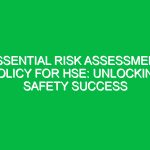Introduction
In the dynamic landscape of the Health, Safety, and Environment (HSE) domain, the risk assessment model stands as a cornerstone for ensuring Workplace Safety and environmental Sustainability. A risk assessment model serves as a structured approach to identifying, evaluating, and mitigating risks that could potentially harm employees, the environment, or the organization itself. As organizations navigate the complexities of modern industries, understanding and implementing an effective risk assessment model becomes not just a regulatory requirement but a moral imperative. This article delves into the intricacies of risk assessment models in the HSE context, offering insights, real-life examples, and Best Practices that can unlock the pathway to Safety success.
Understanding the Risk Assessment Model
At its core, a risk assessment model is a systematic framework used to analyze Hazards and risks associated with specific activities, processes, or environments. The primary goal is to predict potential adverse Effects and implement controls to mitigate those risks. The process typically involves several key steps:
- Hazard Identification: This initial stage involves recognizing potential Hazards that could cause harm.
- Risk Analysis: Once hazards are identified, the next step is to assess the likelihood and severity of potential incidents.
- Risk Evaluation: This involves prioritizing the risks based on their analyzed impact and likelihood.
- Risk Control: Implementing measures to eliminate or minimize risks.
- Monitoring and Review: Continuous assessment to ensure the effectiveness of the risk controls.
Each step is essential for a thorough understanding of the risks involved and the appropriate strategies to address them. By employing a comprehensive risk assessment model, organizations can not only comply with legal requirements but also foster a proactive Safety culture.
Key Components of the Risk Assessment Model in HSE
To effectively implement a risk assessment model within the HSE framework, it is crucial to understand its key components:
1. Hazard Identification
Hazard identification is the first step in any risk assessment model. It involves recognizing anything that could potentially cause harm. This can include physical hazards, chemical exposure, ergonomic risks, and even psychosocial factors. For example, in a manufacturing environment, common hazards may include machinery, chemical spills, or noise levels. A practical approach here is to conduct workplace inspections, employee interviews, and reviews of incident reports to gather comprehensive data on potential hazards.
2. Risk Analysis
After identifying hazards, the next step is to analyze the associated risks. This involves evaluating both the likelihood of an incident occurring and its potential impact. Tools such as risk matrices can be useful in this phase. For example, a construction site may analyze risks related to falling objects and assess both the probability of such incidents and the severity of injuries that could result.
3. Risk Evaluation
Risk evaluation prioritizes the identified risks based on their significance. This step often involves comparing estimated risks against pre-established criteria to determine which risks are acceptable and which require action. For instance, in the oil and gas industry, a risk evaluation might highlight that while the risk of spills is low, the consequences could be catastrophic, warranting urgent attention.
4. Risk Control
Risk control is where the real action happens. This involves implementing measures to eliminate or minimize risks. Control measures can range from engineering controls, such as installing safety guards on machines, to administrative controls like revising work Procedures. Training employees on proper safety protocols is another vital aspect of risk control. A notable example is the implementation of lockout/tagout procedures in factories, which significantly reduces the risk of accidental machine start-up during Maintenance.
5. Monitoring and Review
The final step in the risk assessment model is monitoring and review. This phase ensures that the implemented risk controls are effective and remain relevant over time. Regular audits, employee feedback, and continuous monitoring of risk factors are essential to adapt to any changes in the workplace environment or processes. For instance, a manufacturing plant may conduct quarterly reviews to assess the effectiveness of its Safety Measures and identify any new hazards that may have emerged.
Benefits of an Effective Risk Assessment Model
Implementing a robust risk assessment model yields numerous Benefits for organizations within the HSE domain:
- Enhanced Safety: By identifying and mitigating risks, organizations can significantly reduce workplace accidents and injuries.
- Regulatory Compliance: Many industries are subject to strict Regulations regarding health and safety; a sound risk assessment model helps ensure compliance.
- Improved Productivity: A safe workplace is a productive workplace. Reducing accidents and injuries can lead to fewer disruptions in operations.
- Cultural Shift: Establishing a risk assessment model fosters a culture of safety within the organization, encouraging employees to prioritize safety in their daily activities.
Best Practices for Implementing a Risk Assessment Model
To fully realize the benefits of a risk assessment model, organizations should adhere to several Best Practices:
- Engagement: Involve employees at all levels in the risk assessment process. Their insights can be invaluable in identifying hazards and developing effective controls.
- Training: Provide ongoing Training to employees on risk assessment procedures and safety protocols.
- Documentation: Keep thorough documentation of all risk assessments, findings, and Control Measures to facilitate audits and future assessments.
- Regular Updates: Continuously review and update risk assessments as changes occur in the workplace.
Real-Life Example: The Oil and Gas Industry
The oil and gas industry provides a compelling case study for effective risk assessment models. Due to the high-risk nature of operations, companies in this sector have developed comprehensive models to ensure safety. For example, BP’s implementation of the Bow Tie model has been instrumental in identifying risks and developing Control Measures. This model visually represents the relationship between potential hazards, their consequences, and the controls in place to mitigate risks. Through rigorous training and adherence to this model, BP has significantly reduced incidents and improved safety outcomes.
Regulations and Standards Governing Risk Assessment Models
Various regulations and standards govern the implementation of risk assessment models within the HSE context. For instance, the Occupational Safety and Health Administration (OSHA) in the United States mandates employers to provide a safe workplace, which includes conducting risk assessments. Similarly, the ISO 45001 standard outlines requirements for an Occupational Health and safety management system, emphasizing the need for risk assessments. Understanding these regulations is crucial for organizations to ensure compliance and protect their employees.
Conclusion
The risk assessment model is an essential tool in the HSE domain, providing a structured approach to identifying and mitigating risks that threaten employee safety and environmental integrity. By understanding its components, benefits, and best practices, organizations can unlock the pathway to safety success. Implementing a robust risk assessment model not only fulfills regulatory obligations but also fosters a culture of safety and sustainability. As we navigate an increasingly complex world, prioritizing health, safety, and environmental considerations will be key to achieving long-term success. Embracing these practices is not just a necessity; it’s a commitment to the well-being of every individual in the workplace.


